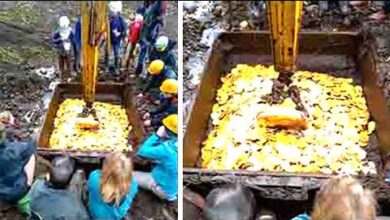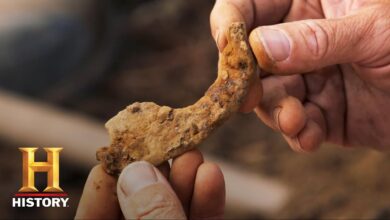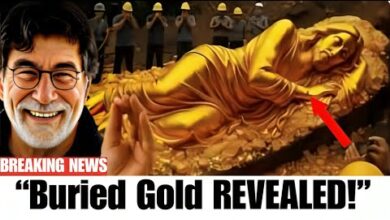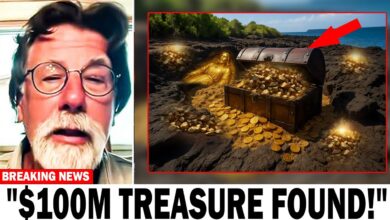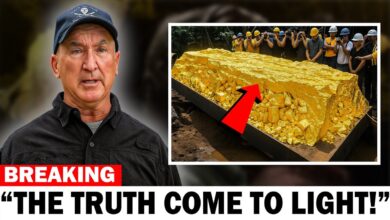The Curse of Oak Island: Unusual Artifact Excites the Team (Season 11)
The Curse of Oak Island: Unusual Artifact Excites the Team (Season 11)

[Gary] This is our chance
to shine, Rick.
-Lot 5.
-[Rick] Yep.
[narrator] Rick Lagina
and metal detection expert
Gary Drayton
arrive on Lot 5
to look for more clues
that might reveal
who built the mysterious
stone structures
located in this area, and why.
[Gary] I’ve gone over
all this stuff.
-Mm-hm.
-And I’ve got a lot of flags.
I’ve got a dozen flags
in this area,
and all of these spoils
came from the bottom
of that hole, so…
it should be the deepest finds.
[narrator] They are starting
their search in the spoils
that have recently
been removed
from a circular depression.
A fissure where
they have found artifacts
dating between the 17th
and mid-18th centuries.
-[beeping]
-Pretty good.
Yeah, pretty good.
I’m in agreement, mate.
Pretty good.
[narrator] After detecting
and flagging
a number of potential targets
earlier today,
Gary and Rick
have now received permission
from archaeologist
Laird Niven to dig them up.
-[beeping]
-It’s out.
[Gary] Come on.
Let’s be something good.
[beeping]
-[Rick] Is that…
-[Gary] Nope.
[rapid beeping]
It’s in my hand.
Which means it’s small.
[Rick] Mm-hm.
[Gary] There.
-[beeping]
-[Gary] It’s out.
-A lead shot.
-Mm-hm.
-[Rick] Small caliber too.
-[Gary] Yeah.
-It’s an oldie.
-Very cool.
[Gary] Get the lead tested.
I’d say its period,
for the lot…
all the finds we’d finding,
they’re going way back
to the early 1700s.
Could be anywhere in the 1700s.
Maybe a little bit older.
It could be military.
[narrator] A lead shot?
Found in the spoils
removed
from the circular feature
on Lot 5?
And possibly dating back
to the 1700s?
If so, could it be another clue
potentially related to
the Duc d’Anville’s ship’s log?
Which detailed a French
naval mission
to hide treasure on an island
in this area back in 1746.
-Right. Let’s find some more.
-[Rick] Okay.
[beeping]
That could go either way.
Yeah, that was broken up.
[beeping]
[Gary] Something good!
[beeping]
-That was it.
-A shell casing.
Is it? No, it is not
a shell casing like that.
It’s an unusual find.
-Oh, is it?
-Look at that, mate.
[Gary] I don’t know, it…
You know, the archaeologists
are over there.
-Mm-hm.
-Should we call Helen over?
-Sure.
-Helen, check this out!
Hey, Gary.
You guys found something?
-[Gary] Yeah, look at that.
-[Rick] What d’you make of that?
[Helen] Oh, look at that.
[Gary] Hopefully,
you have an idea of what it is.
[Rick] What is that?
I would say,
it’s like, you know,
gun-related.
-Yeah?
-[Helen] It looks like a sight.
[Gary] Well, it’s really, really
special-looking.
And I’m glad you went to gun,
because I was thinking old guns.
Yeah.
I mean, to me, that looks like
a gun sight, right?
-[Gary] Could be.
-[Helen] Yeah, that’s nice.
-[Gary] For sure.
-[Helen] Yeah.
Well, thanks
for your input, Helen.
Okay.
[Rick] We have found items
that we believe
have some military context.
This may be another of them.
Again, this speaks
to an enterprise here
could possibly have been
conducted
by the Duc d’Anville
expedition.
The good news is,
they can be tested.
How about taking this lot
back to the lab?
I’m really, really curious.
That copper,
barrel-shaped artifact.
That’s special.
Let’s add that to the database
and keep going.
[Gary] Okay, mate.
Back to the lab.
[narrator]
Later that afternoon,
in the Interpretative Center.
[man]
So what do we have today?
This artifact came off Lot 5.
Not too far off
the round feature.
It may be gun-related.
[narrator] Rick Lagina,
Craig Tester,
and other members of the team
meet with archaeologist
Laird Niven
and archaeometallurgist
Emma Culligan,
to get their analysis
of the artifact found
one day ago on Lot 5.
So it’s a ramrod guide
for a musket.
This would be in there,
and the ramrod
would come through
the front tube,
this would be the center tube.
And be held in with a third one.
[narrator]
The smoothbore long gun,
known as a musket,
was invented in Europe
near the beginning
of the 16th century.
Fire!
[narrator] A feature known
as a ramrod guide
was designed
for aiding the operator
in the loading of lead
or stone projectiles
into the muzzle of the musket.
And what type of musket?
That’s the million-dollar
question.
Exactly.
If it’s a musket,
that would make it
pretty old then.
Yeah.
-Anywhere from 1600s to 1800s.
-Yeah.
-You gotta love that patina.
-Yeah.
That tells you it’s really old.
[Laird] The only strange thing
is that there’s a little
tiny hole here
which I haven’t seen in others.
It seems fancy.
Well, it’d be nice to know…
French, British…
-Mm-hm.
-Yeah.
You know,
some nationality to that.
-You want to see the CT image?
-[Rick] Sure.
[narrator] Earlier this morning,
Emma processed the artifact
using a SkyScan 1273
CT scanner.
By emitting non-destructive
X-ray radiation,
the device can penetrate
built-up corrosion on objects,
revealing clear
3D images of them
along with their finer details.
[Emma] It’s just loading.
[Rick] The little hole
just turned big.
-That’s a clean scan.
-[Emma] Yeah.
[both] Yeah.
[Laird]
See in the top right?
-[Rick] Yeah.
-[Craig] Ooh, yeah.
[Rick] It looks like
there’s Roman numerals.
We get those crazy
Roman numerals
-in the U-shape structure.
-Yeah.
The only thing I can think of
is that could be, uh…
it could be a regiment, I guess.
-It’s an odd thing to mark.
-[Craig and Rick] Yeah.
Those look like V-1-1-1-1,
doesn’t it?
-We saw that in Smith’s Cove.
-Right.
-On U-shaped structures.
-Yeah.
[narrator] In the early 1970s,
Rick, Marty and Craig’s
late partner, Dan Blankenship,
built an earthen coffer dam
that surrounded Smith’s Cove
on the eastern end
of Oak Island
in order to drain the area
and look for evidence
of a legendary
flood tunnel system
that acted as a booby trap
for the original money pit.
Dan was amazed
to uncover a 65-foot-long
U-shaped wooden structure
that featured Roman numerals
and which he believed
was constructed
as a surrounding barrier
for the flood system.
There’s probably a ramrod
waiting for us
somewhere in that area.
[narrator] Is it possible
that the U-shaped structure
along with the other features
and artifacts
that have been found on Lot 5
may be connected
to a 1746 ship’s log
which detailed how treasure
was securely buried
in a deep pit
on a wooded island?
[foreboding music playing]
[Rick]
Finding the Roman numerals
carved on that little bit
of ramrod guide,
it brought back memories
certainly of the U-shaped
structure.
We’ve never found
Roman numerals before
on any other artifact, to date.
And to have them found here,
I think the two
are strongly connected.
[Gary] Absolutely fantastic.
This has given us hope,
that there’s more finds
on Lot 5.
I say we give it another shot.
I want to find the rest of it.
-I’m in.
-Okay.
All right. Good luck.
-Thank you, Laird.
-Thanks, Laird.
